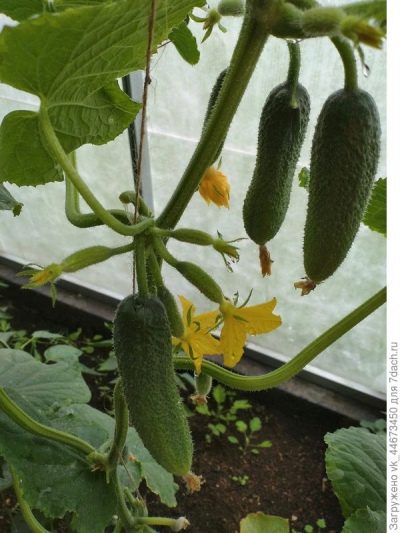
- Authors: N.V. Nastenko, V.G. Kachainik, M.N. Gulkin, (LLC Agrofirma "Aelita")
- Year of approval: 2012
- Growth type: vigorous, indeterminate
- Branching: the average
- Fruit weight, g: 90-100
- Fruit length, cm: 9-10
- Fruit color: green, with light stripes of medium length
- Cucumber Mosaic Virus Resistance: stable
- Ripening terms: early
- Pollination: bee-pollinated
The variety Baby on a Branch was bred not so long ago, in 2011. The work was carried out by the specialists of the agrofirm "Aelita". A year after breeding, the variety was included in the state register of the Russian Federation and recommended for cultivation on private plots. The new variety is very fond of summer residents from many areas.
Description of the variety
Hybrid cucumber Babies on a branch is an early hybrid that is pollinated by bees and is adapted for growing both in greenhouses and in open soil. The fruits of such cucumbers are incredibly tasty and aromatic, albeit small. This variety grows on average up to 10 cm. The variety is vigorous, indeterminate and has a predominantly female flowering type. The number of zelents in a bunch is about 3. Such cucumbers never outgrow, and their growth rate depends on the number of cucumbers in one bosom.
Characteristics of the appearance of plants and zelents
The leaves of such cucumbers are green, rounded, of medium size; upon closer examination, you can notice a slightly pronounced five tops. The stem is rather large, has a light green tint. Fruits of the variety Babies on a branch are green in color and have light stripes of medium length, which come from the light nose of the cucumber. The cucumber is covered with small tubercles with white thorns; there is also a barely noticeable gray down. The peel of such cucumbers is of medium hardness, crisp loudly.
Purpose and taste of fruits
The fruits are cylindrical in shape and are short in themselves. Tasting a cucumber, it becomes clear that the variety is truly juicy and does not taste bitter, it has absolutely no voids inside. There are small bones that are not felt at all. Initially, the variety was announced as a salad, but later culinary experts came to the conclusion that such cucumbers are still great for pickling and pickling.
Maturation
This hybrid is early, so the period for which it ripens is 42-45 days from germination. Sowing, in turn, is early and should be carried out from April to May. It is recommended to harvest the fruits every 2-4 days. Such cucumbers ripen at the same time and in large quantities, which allows the owners of the dacha to harvest, stopping by only a couple of times a week, which is good news.
Yield
This variety is bunchy, which is why its yield will be high. Thus, you can collect approximately 10-10.7 kg / sq. m. The mass of a cucumber can be from 90 to 100 grams. Don't forget to fertilize for great results. In case of frost, it will be necessary to build a shelter in order to avoid the death of the sprouts.
Growing and caring
Growing such a variety is in an open place, since it requires bee pollination. Planting density should be 4-5 bushes per 1 square meter in open field. If you only have a greenhouse, then 2-3 bushes per square meter are planted in it. When growing a variety in a greenhouse, the cucumber must be fixed; for this, you can use a trellis or stretched ropes. It is important to care for the cucumbers properly in order to maintain their "tuft" and harvest more crops.
It is necessary to ensure that the soil does not dry out and water it in a timely manner. Also, an important part of growing will be considered the use of mineral fertilizers at least once a week. When reducing the ovaries, it is necessary to reduce the amount of feeding.

In order to collect strong, tasty and beautiful cucumbers on your site, you need to make top dressing. Lack of nutrients can negatively affect the appearance of the plant and significantly reduce the yield. Fertilize cucumbers with organic fertilizers in combination with mineral fertilizers. With the right balance of these components and adherence to the fertilizing schedule, the cucumber yield will be maximum.
Disease and pest resistance
Cucumbers Babies on a branch are considered to be one of the most resistant varieties to all kinds of pests and diseases. But this plant, like any other, can get sick if you approach its care incorrectly. So, with improper care, spider mites or aphids may appear, but this problem can be easily solved by treating the crop with onion infusion.

Despite their popularity, cucumbers are often attacked by diseases and pests. From them, cucumber plantings often die before the start of fruiting. In order to prevent this from happening, it is necessary to try to prevent ailments or get rid of them at the very beginning, having studied in detail their causes of occurrence, signs and methods of treatment.





























































































